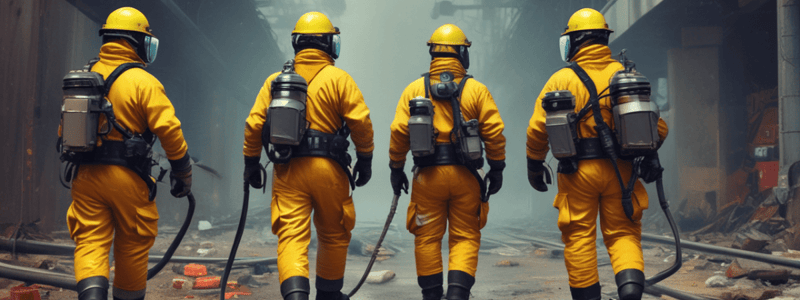Podcast
Questions and Answers
What is the first step TFS personnel should take when responding to a hazardous materials incident?
What is the first step TFS personnel should take when responding to a hazardous materials incident?
- Identify the hazard
- Request additional assistance
- Secure the scene
- Approach cautiously (correct)
What is the purpose of staging responding vehicles upwind and upgraded away from vapor clouds?
What is the purpose of staging responding vehicles upwind and upgraded away from vapor clouds?
- To communicate with the public
- To coordinate with other responders
- To get a better view of the incident
- To keep responders safe from exposure (correct)
Why should TFS personnel isolate the hazard area?
Why should TFS personnel isolate the hazard area?
- To keep responders safe from exposure
- To allow for easier access to the incident
- To prevent further damage to the environment
- To keep interested citizens and media out of the area (correct)
What resource can be used to positively identify a hazard?
What resource can be used to positively identify a hazard?
What should TFS personnel consider when assessing a hazardous materials incident?
What should TFS personnel consider when assessing a hazardous materials incident?
When should TFS personnel request the attendance of a Heavy Hazmat Unit?
When should TFS personnel request the attendance of a Heavy Hazmat Unit?
What is a critical consideration when deciding on site entry?
What is a critical consideration when deciding on site entry?
Why is it important for TFS personnel to avoid exposure to hazardous materials?
Why is it important for TFS personnel to avoid exposure to hazardous materials?
What is the primary consideration when responding to a hazardous materials incident?
What is the primary consideration when responding to a hazardous materials incident?
What should be done before entering a hazardous materials incident scene?
What should be done before entering a hazardous materials incident scene?
What should be considered when selecting PPE for a hazardous materials incident?
What should be considered when selecting PPE for a hazardous materials incident?
Why should you avoid contact with spilled material?
Why should you avoid contact with spilled material?
What should be done with casualties at a hazardous materials incident?
What should be done with casualties at a hazardous materials incident?
When should offensive corrective action be taken at a hazardous materials incident?
When should offensive corrective action be taken at a hazardous materials incident?
Flashcards are hidden until you start studying
Study Notes
General Guidelines for Hazardous Materials Incidents
- TFS personnel should approach cautiously, secure the scene, identify the hazard (if possible), assess the situation, request additional assistance, and determine whether or not entry can be made safely when responding to hazardous materials incidents. Respond appropriately and avoid exposure.
Response Guidelines
- Approach cautiously from upwind, and stage responding vehicles upwind and away from vapour clouds.
- Secure the scene by isolating and denying entry into the area, and keeping interested or concerned citizens and media out of the hazard area.
- Identify the hazards using available resources, including placards, labels, U.N/I.D numbers, container types, and knowledgeable persons on-site.
- Consider the following factors when assessing the situation:
- Is there a fire, a spill, or a leak?
- Are there any casualties?
- What are the weather conditions?
- What is the terrain like?
- Who/what is at risk: people, the environment, or property?
- What actions should be taken: Is an evacuation necessary? Is diking necessary? What resources (human and equipment) are required and are readily available?
- What has been done prior to your arrival?
- What can you do based on your training and equipment, and do you need help?
Obtaining Help and Deciding on Site Entry
- Request the attendance of a Heavy Hazmat Unit and proper resources (police) to control traffic/people and to provide medical aid (paramedics) if required.
- After doing a risk/benefit analysis, determine whether or not entry can be made safely, considering factors such as:
- Is PPE appropriate for anticipated task (entry, rescue)?
- Product characteristics (solid, liquid, gas)?
- Viability of victim(s)?
Responding Appropriately
- Establish command in accordance with Incident Management System.
- Establish a Command Post and lines of communication.
- Identify and assign tasks and responsibilities.
- Rescue casualties where possible and evacuate if necessary.
- Maintain site control.
- Continually reassess the situation and modify the response accordingly.
- The first duty is to consider the safety of people in the immediate area, including responders.
Avoiding Contact
- Do not walk into or touch spilled material.
- Avoid inhalation of fumes, smoke, and vapors, even if no dangerous goods are known to be involved.
- Do not assume that gases or vapors are harmless because of lack of a smell — odorless gases or vapors may be harmful.
Avoiding Offensive Corrective Action
- Avoid taking offensive corrective action at a hazardous materials incident until the chemical can be identified and the hazards are known.
Studying That Suits You
Use AI to generate personalized quizzes and flashcards to suit your learning preferences.




